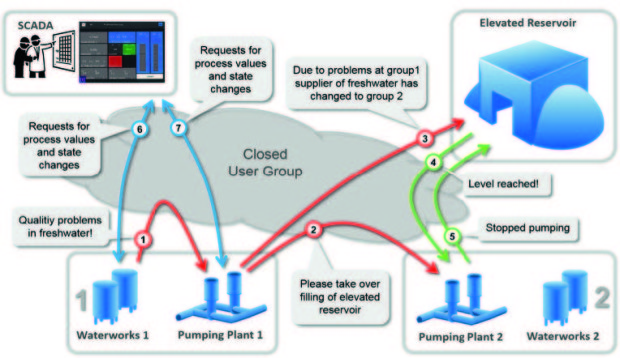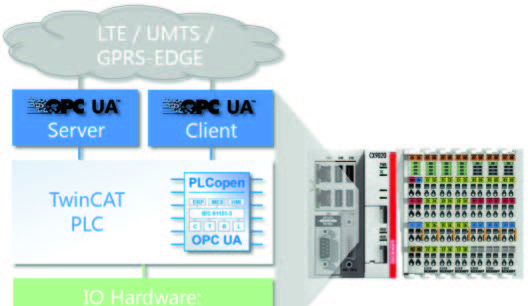 by Silvio Merz,
by Silvio Merz,
Decentralized, independently acting embedded controllers can form an intelligent network for the control of potable water and wastewater plants. OPC-UA is a powerful technology to establish secure and standardized M2M interaction at these plants.
The movement toward the 4th industrial revolution, or Industry 4.0, is gaining momentum in a wide range of industries, and water treatment can now be counted as an application example. Some of the requirements of the Industry 4.0 initiative, such as platform and vendor-independent communication, data security, standardization, decentralized intelligence and engineering for M2M (machine-to- machine) or IoT (Internet of Things) applications, are already available in the OPC Unified Architecture (UA).
OPC-UA is used for M2M communication between plants for the intelligent networking of decentralized, independently acting, very small embedded controllers. For example, an application with the Joint Water and Wastewater Authority, Vogtland (ZWAV), has around 300 potable water plants and 300 wastewater plants (pumping plants, waterworks, elevated reservoirs, etc.) distributed over 1,400 km2 and covering 40 cities with 240,000 people.
Real objects (e.g. pumps) were modeled in the TwinCAT IEC 61131-3 PLC software from Beckhoff Automation as complex objects with interactive possibilities. Since the OPC-UA server was integrated in the controller, these objects are automatically available to the outside world as complex data structures for semantic interoperability. The result was decentralized intelligence that makes decisions independently and can transmit information to neighboring systems. In addition, it can query equipment status and values for its own process in order to ensure trouble-free process cycles.
With the standardized PLCopen function blocks, the devices independently initiate communication from the PLC to other process devices such as OPC-UA clients, while at the same time being able to respond to their requests or to requests from higher-level systems (SCADA, MES, ERP) as OPC-UA servers.
The devices are connected by wireless router. A physical interruption of the connection does not lead to a loss of information, since information is automatically buffered in the OPC-UA server for a time and can be retrieved as soon as the connection has been restored – a very important property in which a great deal of proprietary engineering effort was invested beforehand. The authentication, signing, and encryption safety mechanisms integrated in OPC-UA were used in addition to a closed mobile radio group to ensure the integrity of this partly-sensitive data.
The vendor-independent interoperability standard OPC-UA opens up the possibility for end users to subordinate the selection of a target platform for the required technology in order to avoid using proprietary products or devices that don’t meet the needs of the application.
A significant increase in efficiency, cost reductions and quality improvements was gained using the IEC 61131-3 PLC in engineering. The prerequisite here is an object-oriented approach to transplant intelligence into the PLC . The control system or a local visualization is handled simply as
an “image” on the PLC
The key advantage is that there’s no need to manage multiple configurations or scaling – or the associated errors. Also, with the cooperation between the OPC Foundation and PLCopen, a similarly high impact can be achieved on the PLC. Through structuring and modularization, data structures or their elements for data access, alarms and conditions or historical access are prepared once in an object-oriented manner in the PLC source code. This can save users significant amounts of programming time.
“The replacement of a proprietary solution with a combined OPC UA client/ server solution in small, but powerful embedded controllers provided ZWAV with savings on the initial licensing costs of more than 90 percent per device,” said Silvio Merz, Divisional Manager, Electrical/Process Technology , Joint Water and Wastewater Authority, Vogtland.
“Minimizing service assignments in the field results in significant additional savings for maintaining several hundred water facilities within an area of 1,400 km2. For the engineering part, better standardization results in:
- Efficient engineering
- Cost reductions
- Reuse of technology/equipment
- Improved transparency
- Increased availability
- Increased choice of providers
- Higher interoperability
“The considerable potential for business management optimization is more than worth putting together existing and new technologies,” he added.

